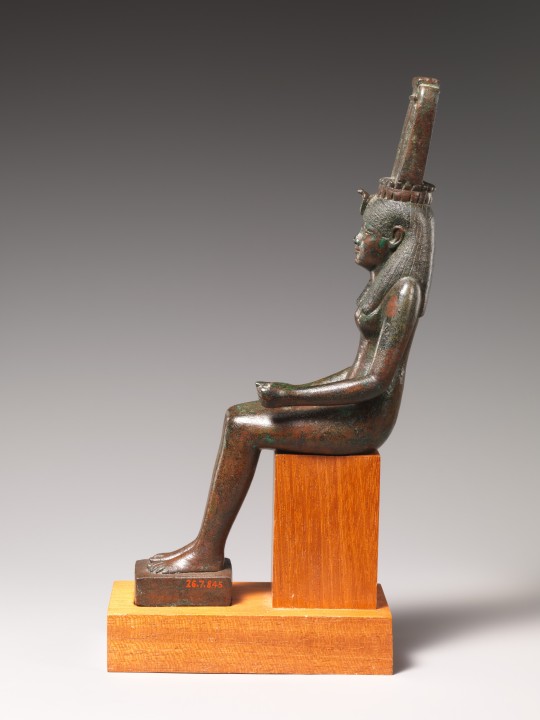#Hathor Nebethetepet
Explore tagged Tumblr posts
Text



Statue of a goddess, probably Nehemetaui or Nebethetepet Late Period–Ptolemaic Period Dynasty 27–30 550–300 B.C.
The shrine-shaped sistrum sound-box worn as a crown by this figure indicates that either the goddess Nehemet-aui, the consort of Thoth, or Nebethetepet, a manifestation of Hathor, is represented. The features of the goddess suggest a date to the end of the 26th dynasty, or the 30th dynasty. As the kings of the 30th Dynasty built important buildings including a temple to the goddess Nehemet-aui at Hermopolis, the seat of the god Thoth, it is plausible this statue is Nehemet-aui.
H. 17.8 × W. 4.3 × D. 10 cm (7 × 1 11/16 × 3 15/16 in.). H. (with tang): 20 cm (7 7/8 in.).
#Statue of a goddess#Nehemetaui#Nebethetepet#Late Period–Ptolemaic Period#statue#egyptian statue#ancient artifacts#archeology#archeolgst#history#history news#ancient history#ancient culture#ancient civilizations#ancient egypt#egyptian history#egyptian art
120 notes
·
View notes
Text

Votive Ear Stele of Usersatet
The ear stele of Usersatet was dedicated to the goddess Nebethetepet, “she who listens to prayers”. It is decorated with four ears in the hope that the deity would hear and answer to the requests of the dedicator. Originally from Heliopolis, Nebethetepet was a deity who was associated with Hathor and there is even evidence for her cult during the Old Kingdom. Stele decorated with one or more ears have been discovered not only in the village of Deir el-Medina but also at other New Kingdom sites. New Kingdom, 18th Dynasty, ca. 1550-1292 BC. Limestone, 17.5 x 14 x 5.3 cm. From Deir el-Medina, West Thebes. Now in the Egyptian Museum of Turin. Cat. 1546 Read more
16 notes
·
View notes
Photo

Met Museum Menat counterpose for attachment to the missing aegis of a goddess ca. 800–525 B.C. Egyptian Rogers Fund, 1908 (08.202.15) https://www.metmuseum.org/met-around-the-world/?page=10721 (10/210)
#Hethert#hathor#Hethert-Nut#Mother of God#Nebethetepet#Nehmet-Awai#Kemetic#kemetic orthodox#It could be SO many goddesses
3 notes
·
View notes
Photo

Gold Ring Decorated with a Hathor Sistrum The connection of the cat with the Hathor sistrum seems to relate to the role of Hathor as goddess of women, female sexuality, and motherhood. This aspect of Hathor identified her with the Egyptian goddess Nebethetepet, the female counterpart of the creator god, whose most distinctive characteristic was sexual energy, and whose association with the cat was probably due to the animal’s exceptional procreative powers. The ring, which is clearly an Egyptian product, was found in a Late Bronze Age Canaanite tomb at Tell el-Ajjul, indicating that Egyptian amulets besides scarabs were used by the Canaanite population during this period, in emulation of Egyptian customs. New Kingdom, 18th Dynasty, ca. 1500-1300 BC. #iregipto #egyptpassion #thering #bronze #hathor https://www.instagram.com/p/B10xjQOHISC/?igshid=gzhzghx8l8bv
9 notes
·
View notes
Photo

Gold Ring Decorated with a Hathor Sistrum The connection of the cat with the Hathor sistrum seems to relate to the role of Hathor as goddess of women, female sexuality, and motherhood. This aspect of Hathor identified her with the Egyptian goddess Nebethetepet, the female counterpart of the creator god, whose most distinctive characteristic was sexual energy, and whose association with the cat was probably due to the animal’s exceptional procreative powers. The ring, which is clearly an Egyptian product, was found in a Late Bronze Age Canaanite tomb at Tell el-Ajjul, indicating that Egyptian amulets besides scarabs were used by the Canaanite population during this period, in emulation of Egyptian customs. New Kingdom, 18th Dynasty, ca. 1500-1300 BC. Excavated in Tell el-Ajjul, Gaza. Now in the Rockefeller Archaeological Museum, Jerusalem. 1932 #egypt #egyptian #hieroglyphics #ancient#ancientegypt #egyptian #hieroglyphics#tutankhamun #pharaoh #tomb#sarcafogus #gold #inlay #stones #vulture#scarab #worldtourismday #thisisegypt#myegypt #egypttourism #terisheri#ahmose #ahhtope #bracelet #lapis#jewelry #teti #cuff #ornament #queen#king (at Rockefeller Museum) https://www.instagram.com/p/B9ANHykhuSS/?igshid=11vf84sr7hv00
#egypt#egyptian#hieroglyphics#ancient#ancientegypt#tutankhamun#pharaoh#tomb#sarcafogus#gold#inlay#stones#vulture#scarab#worldtourismday#thisisegypt#myegypt#egypttourism#terisheri#ahmose#ahhtope#bracelet#lapis#jewelry#teti#cuff#ornament#queen#king
0 notes
Photo

It’s that goddess again! Nehemtawy (far right, with a shrine on her head). According to Olaf Kaper’s Temples and Gods in Roman Dakhleh, this is Ra-Horakhty and Hathor Nebethetepet. The goddess behind pharaoh is Nephthys, seated behind a falcon-headed Set.
Courtesy of Meretseger Books.
#Ancient Egypt#Hathor#Hathor Nebethetepet#Nephthys#Set#Seth#Ra Horakhty#Sutekh#falcon headed Set#Roman Egypt#temple
8 notes
·
View notes
Photo

Gold Ring Decorated with a Hathor Sistrum The connection of the cat with the Hathor sistrum seems to relate to the role of Hathor as goddess of women, female sexuality, and motherhood. This aspect of Hathor identified her with the Egyptian goddess Nebethetepet, the female counterpart of the creator god, whose most distinctive characteristic was sexual energy, and whose association with the cat was probably due to the animal’s exceptional procreative powers. The ring, which is clearly an Egyptian product, was found in a Late Bronze Age Canaanite tomb at Tell el-Ajjul, indicating that Egyptian amulets besides scarabs were used by the Canaanite population during this period, in emulation of Egyptian customs. New Kingdom, 18th Dynasty, ca. 1500-1300 BC. Excavated in Tell el-Ajjul, Gaza. Now in the Rockefeller Archaeological Museum, Jerusalem. 1932-1810#Tutankhamun ⠀⠀⠀ #egypt #ancientegypt #pharaohs #egyptian#äegypten #egyptology #wondersofegypt#ancient #archeology #middleeast#madeinegypt #hyeroglyphs #jewellery#Egipto #antiguoegipto #faraones#egipcios #egiptologia #antiguedades#arqueologia #jeroglificos #momias#kemet #loveegypt #thisisegypt #myegypt#egyptianhistory #tutankhamon (at Rockefeller Museum) https://www.instagram.com/p/B1ogcC3A-OF/?igshid=1obpqz8ojgf9d
#tutankhamun#egypt#ancientegypt#pharaohs#egyptian#äegypten#egyptology#wondersofegypt#ancient#archeology#middleeast#madeinegypt#hyeroglyphs#jewellery#egipto#antiguoegipto#faraones#egipcios#egiptologia#antiguedades#arqueologia#jeroglificos#momias#kemet#loveegypt#thisisegypt#myegypt#egyptianhistory#tutankhamon
1 note
·
View note